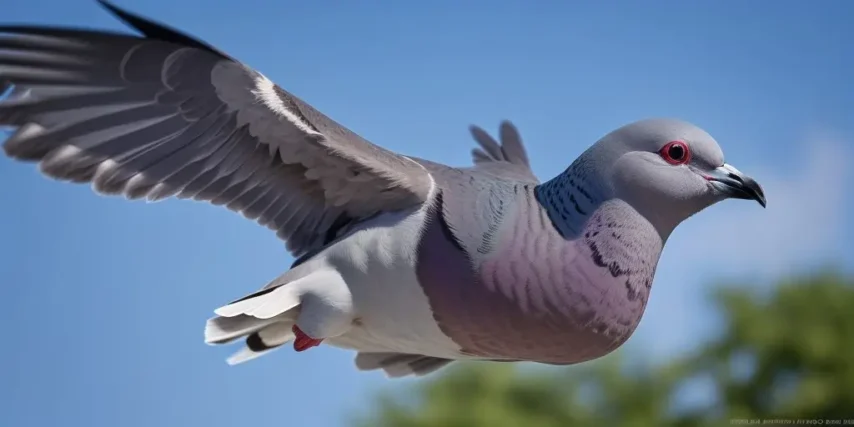Unraveling the Mysteries of Pigeon Flight: A Feat of Nature’s Engineering
In the bustling streets of our cities, amidst the skyscrapers and bustling crowds, there exists a creature often overlooked yet remarkable in its own right: the humble pigeon. These seemingly ordinary birds possess an extraordinary ability – flight. But what exactly enables pigeons to take to the skies with such grace and efficiency? Join us as we delve into the intricacies of pigeon flight, uncovering the secrets behind this marvel of nature’s engineering.

Anatomy and Physiology:
Before exploring the mechanics of pigeon flight, it’s essential to understand the anatomy and physiology that make it possible. Pigeons belong to the avian class Aves, characterized by lightweight yet robust skeletons, powerful muscles, and specialized respiratory and circulatory systems.
Their skeletal structure is optimized for flight, featuring hollow bones that reduce weight without compromising strength. Additionally, their keel bone provides ample attachment points for the powerful flight muscles necessary for sustained aerial movement.
Pigeons possess a highly efficient respiratory system, with air sacs throughout their bodies facilitating a continuous flow of oxygen during flight. Their circulatory system ensures rapid oxygen delivery to muscles, enabling sustained flight over long distances.
Wing Design and Aerodynamics:
Central to the phenomenon of pigeon flight is their remarkable wing design and the principles of aerodynamics governing their movement through the air. Pigeon wings exhibit a unique combination of strength, flexibility, and efficiency, allowing for precise control and maneuverability.
At rest, a pigeon’s wings are neatly folded against its body, minimizing drag and conserving energy. However, once in flight, their wings undergo a transformation, extending to reveal a complex arrangement of feathers that generate lift and thrust.
The shape of a pigeon’s wing, characterized by a curved leading edge and tapered trailing edge, is optimized to harness the forces of lift and drag. As air flows over the wing’s surface, it creates a pressure differential, with lower pressure above the wing and higher pressure below, resulting in upward lift.
Furthermore, pigeons employ various flight techniques, including flapping and gliding, to conserve energy during flight. Flapping motions provide propulsion, while gliding allows pigeons to cover vast distances with minimal effort, exploiting air currents and thermals to maintain altitude.

Navigation and Homing Instincts:
In addition to their remarkable flying abilities, pigeons are renowned for their innate navigation skills and homing instincts. These capabilities have fascinated humans for centuries, leading to their historical use as messengers and symbols of communication.
The exact mechanisms underlying pigeon navigation remain a subject of ongoing research, but several factors contribute to their remarkable homing abilities. Pigeons possess a keen sense of direction, relying on visual landmarks, the Earth’s magnetic field, and possibly even olfactory cues to navigate their surroundings.
One prevailing theory suggests that pigeons use a combination of visual, magnetic, and celestial cues to orient themselves during flight. By memorizing key landmarks and sensing subtle changes in the Earth’s magnetic field, pigeons can accurately navigate over vast distances, returning to their home loft with remarkable precision.

Implications and Future Research:
The study of pigeon flight not only provides insights into the fascinating adaptations of these avian species but also holds potential applications in various fields, including robotics, aerospace engineering, and environmental monitoring.
By understanding the biomechanics of pigeon flight, researchers can develop innovative technologies inspired by nature’s designs, such as bio-inspired drones and unmanned aerial vehicles capable of navigating complex environments with agility and efficiency.
Furthermore, ongoing research into pigeon navigation and homing instincts could yield valuable insights into animal behavior, cognition, and sensory perception. By unraveling the mysteries of pigeon flight, scientists may unlock new frontiers in our understanding of the natural world and our place within it.
In conclusion, the flight of pigeons stands as a testament to the ingenuity and adaptability of nature. From their specialized anatomy and aerodynamic prowess to their remarkable navigation abilities, pigeons embody the wonders of evolution and the beauty of the natural world.
As we continue to explore the secrets of pigeon flight, we gain not only a deeper appreciation for these extraordinary birds but also valuable insights that may shape the future of technology and science. So the next time you glimpse a pigeon soaring overhead, take a moment to marvel at the intricate mechanics of its flight, knowing that beneath its unassuming exterior lies a true marvel of nature’s engineering.







